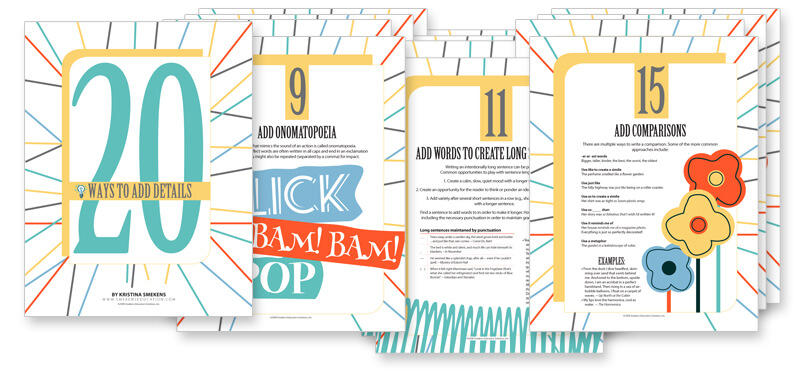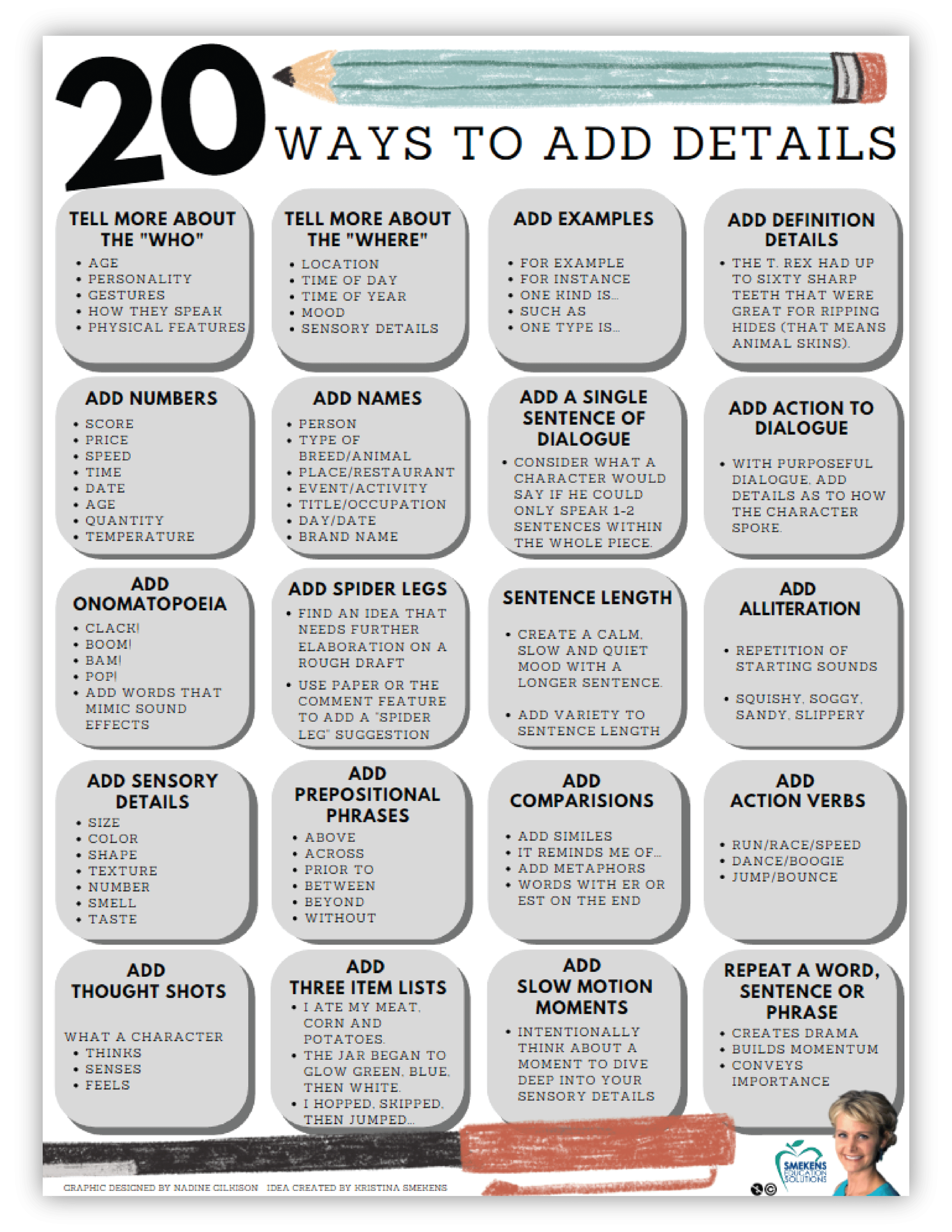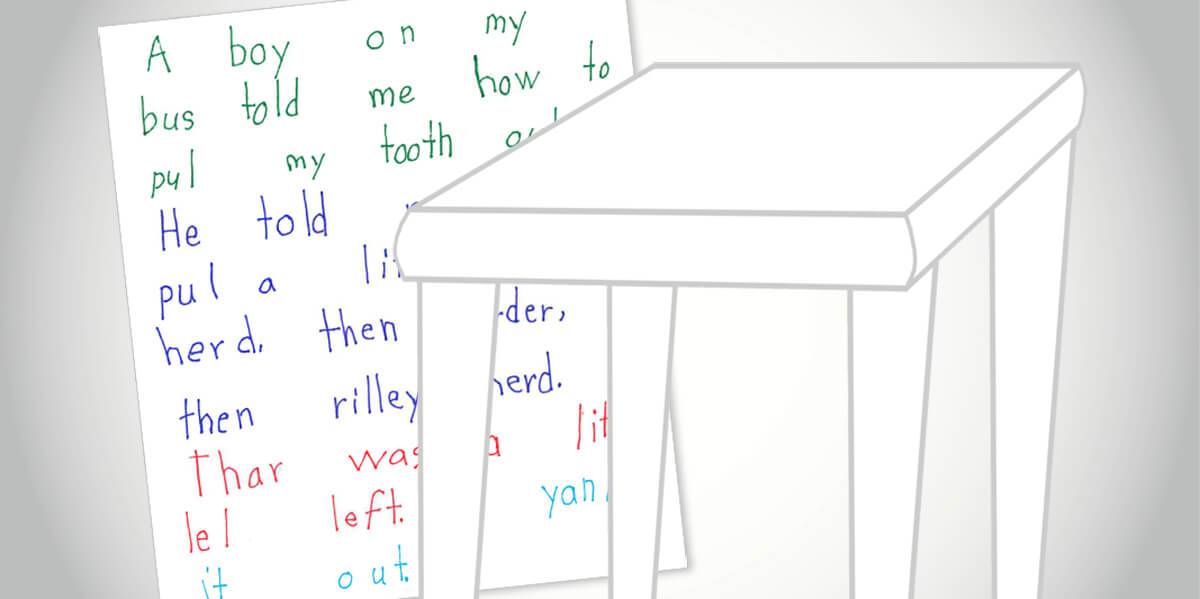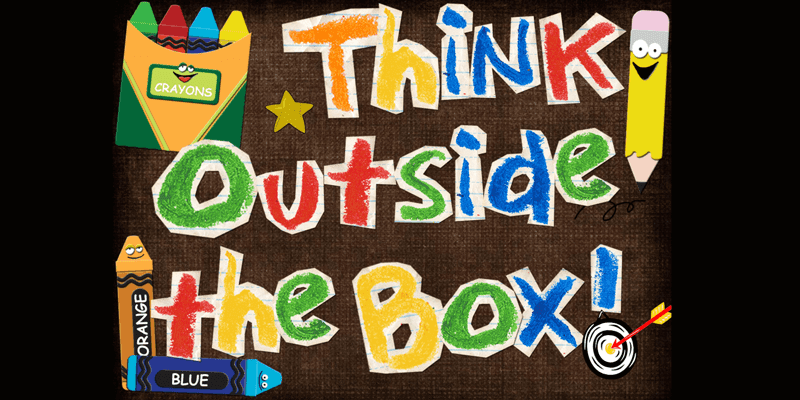Learning Center
reading
Teach 20 ways to develop an idea and add details to narratives
April 29, 2024

Many students struggle to develop ideas when writing narrative stories. This doesn’t necessarily mean students’ writing lacks material though. Start with what they have already written.
Beyond telling students to “add more details” to a narrative, teach them how to develop ideas in writing with 20 different strategies that add layers of detail and bring their stories to life. Download a PDF of the 20 ways to develop an idea and add details to narratives.
1. TELL MORE ABOUT THE “WHO”: Add details about the character. These kinds of details reveal what the subject or character looks like and how they act or speak.
2. TELL MORE ABOUT THE “WHERE”: A vivid setting emerges by developing ideas about the location, time of day, time of year, established mood, or details that bring the scene to life through the reader’s senses.
3. ADD EXAMPLES: Add details with examples to help the reader better understand the topic/information. Examples will clarify meaning, especially if it’s on a topic of which the reader has little
background knowledge.
4. ADD DEFINITION DETAILS: Depending on the writing topic, there may be domain-specific and/or content-related vocabulary within the piece. That said, if the reader is unaware of a word’s meaning, then comprehension suffers. Define terms that may be lesser known. This is also a way for the writer to demonstrate audience awareness.
5. ADD NUMBERS: Add details with specific number facts and statistics (e.g., date, age, quantity, temperature, time, etc.).
6. ADD NAMES: Add details with specific names and proper nouns (e.g., characters, places, events, titles, day/date, city/state, brand names, etc.).
7. ADD A SINGLE SENTENCE OF DIALOGUE: Purposeful dialogue can be effective within a piece. However, in narratives, students often drown the reader in irrelevant, uninteresting dialogue that goes on and on and on. Consider what a character would say if he could only speak 1-2 sentences within the whole piece. What would be vital for reader insight? What is better said through speech than narration?
8. ADD ACTION TO DIALOGUE: With purposeful dialogue, add details as to how the character spoke. When the writer explains what the character said and how he said it, the reader is left with a clearer picture.
9. ADD ONOMATOPOEIA: A word that mimics the sound of an action is called onomatopoeia. These sound-effect words are often written in all caps and end in an exclamation point. They might also be repeated (separated by a comma) for impact.
10. ADD SPIDER LEGS: Find an idea within the current draft that needs further elaboration. Think of a second sentence to develop that idea. Write it onto a spider leg (strip of paper). Tape it onto the draft right where it would fall. Adding “leg” sentences to the “body” is a fun way to encourage elaboration. See how many “legs” a writer can add.
11. ADD WORDS TO CREATE LONG SENTENCES: Writing an intentionally long sentence can be powerful. Common opportunities to play with sentence length include:
1. Create a calm, slow, quiet mood with a longer sentence.
2. Create an opportunity for the reader to think or ponder an idea with a longer sentence.
3. Add variety after several short sentences in a row (e.g., short — short — long) with a longer sentence.
Find a sentence to add details to in order to make it longer. However, be conscious of including the necessary punctuation in order to maintain grammatical correctness.
12. ADD ALLITERATION: Alliteration is a repetition of the starting sounds (letters or syllables) in two or more consecutive (or nearby) words. It creates a musical rhythm and fluency through the writing. It is especially pleasing when read aloud.
13. ADD SENSORY DETAILS: Teach students to develop their ideas with more than just color and number details. Look in literature for examples of well-described, detailed passages. Help students dissect mentor text for the types of description the author utilized.
This skill naturally leads into mini-lessons on “showing, not telling.” Teach students to recreate moments and scenes, rather than tell them to the reader secondhand.
14. ADD PREPOSITIONAL PHRASES: Add prepositional phrases to paint a more detailed picture and provide readers specifics on how, when, where, and which one.
15. ADD COMPARISONS: There are multiple ways to write a comparison. Some of the more common approaches include:
- -er or -est words
- Use like to create a simile
- Use just like
- Use as to create a simile
- Use so _____ that:
- Use it reminds me of
- Use a metaphor
16. ADD ACTION VERBS: Verbs are the engine of the sentence—unfortunately, students often utilize the first verb they think of. Think of action verbs associated with your topic. Incorporate some of these stronger action verbs.
17. ADD THOUGHT-SHOTS: Character dialogue can become predictable and unimportant. However, insights into a character’s thoughts and feelings are always vital and help in developing ideas. Thought-shots are opportunities to “hear” what a character is thinking but not saying.
18. ADD SLOW-MOTION MOMENTS (SNAPSHOTS): Find a moment to stop and develop. What’s a part worth pausing and developing? Bring a moment to life with sensory descriptions, vivid verbs, figurative language, and so much more!
19. ADD THREE-ITEM LISTS: Find a place in the draft where ONE item was mentioned. Turn it into a three-item series–three noun items, three color descriptions, or three actions.
20. REPEAT A WORD, PHRASE, SENTENCE: To create drama, build momentum, and/or convey importance, use repetition for impact. Repeating a word, phrase, or sentence lets the reader know the writer is building toward something. There is a purpose behind the repetition. Its impact will be felt.
Reveal examples
As you teach each strategy, reveal short excerpts or passages from picture books to show students the detail in action. Just telling them to use prepositional phrases, onomatopoeia words, comparisons, or number details isn’t enough. Students may need to see several examples of these elements in context to better understand how they can utilize them in their own writing. Students always need to see the strategy before they can successfully implement it.
While introducing one strategy at a time, consider building a wall chart for these 20 ways to add details. This would provide a constant resource and reference within the classroom environment for the next couple of months.
Student application
Give kids ample opportunity to play with these details by returning to previous writings. If students can’t insert a prepositional phrase as an afterthought, they can’t do it as an initial thought. If they can’t develop an idea using sensory details and comparisons as an afterthought, they won’t be able to do it off the cuff in a new first draft.
Gradually encourage students to apply these different development strategies in new first drafts. Remind them to add specifics and examples to ideas in order to produce long, well-developed writing.







Love having all of these in one spot!
How can I print the Canva version?
To print the Canva version, click on the image and then hit ctrl P as it opens in a new tab. That allows you to print your screen. Or, use a Snip tool to select the open image.